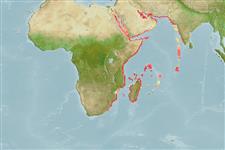Teleostei (teleosts) >
Blenniiformes (Blennies) >
Tripterygiidae (Triplefin blennies) > Tripterygiinae
Etymology: Enneapterygius: Greek, ennea = nine times + Greek, pterygion = little fin (Ref. 45335).
Environment: milieu / climate zone / depth range / distribution range
Ecology
Marine; demersal; depth range 0 - 12 m (Ref. 12476), usually 0 - 1 m (Ref. 12476). Subtropical
Western Indian Ocean: east and soitheast coast of South Africa (Transkei to southern Mozambique), the Red Sea, Aden, Oman, and Pakistan.
Size / Weight / Age
Maturity: Lm ? range ? - ? cm
Max length : 4.0 cm TL male/unsexed; (Ref. 11441)
Dorsal
spines
(total): 14 - 16;
Dorsal
soft rays
(total): 8-10;
Anal
spines: 1;
Anal
soft rays: 17 - 20. This species is distinguished by the following characters: D III + XI-XIII + 8-10 (usually III + XII + 10); A I,17-20 (usually 19); pectoral fin 14: 1-3, 4-6, 6-8 (usually 2, 5, 7). LL, pored scales 13-16, notched scales 21-25, starting at 2 scale rows below the end of the pored series; transverse scales 2/6; nape and abdomen scaleless, first dorsal fin base also without scales. Body depth 4.8-5.2 in SL. Head 3.4-4.0 in SL; eyes large, diameter 3.0-3.7 in head length; orbital cirrus moderate, lobate; supratemporal sensory canal U-shaped and embraces 1st dorsal spine; dentary pores 3+1+3. Male first dorsal fin slightly higher than second; slightly lower in females. Key features are: overall olive green; anal fins black and white barred. Males head black; first dorsal fin, lower pectoral-fin rays and proximal portion of the pelvic-fin rays yellow females (Ref. 57774, 88983).
Female members of the Tripterygiidae have eggs that are hemispherical and covered with numerous sticky threads that anchor them in the algae on the nesting sites (Ref. 240). Larvae are planktonic which occur primarily in shallow, nearshore waters (Ref. 94114).
Life cycle and mating behavior
Maturity | Reproduction | Spawning | Eggs | Fecundity | Larvae
Holleman, W. and S.V. Bogorodsky, 2012. A review of the blennioid fish family Tripterygiidae (Perciformes) in the Red Sea, with description of Enneapterygius qirmiz, and reinstatement of Enneapterygius altipinnis Clark, 1980. Zootaxa 3152:36-60. (Ref. 88983)
IUCN Red List Status (Ref. 130435)
Threat to humans
Harmless
Human uses
More information
Common namesSynonymsMetabolismPredatorsEcotoxicologyReproductionMaturitySpawningSpawning aggregationFecundityEggsEgg development
ReferencesAquacultureAquaculture profileStrainsGeneticsElectrophoresesHeritabilityDiseasesProcessingNutrientsMass conversion
Tools
Special reports
Download XML
Internet sources
Estimates based on models
Preferred temperature (Ref.
123201): 24.8 - 28.9, mean 27.2 °C (based on 725 cells).
Phylogenetic diversity index (Ref.
82804): PD
50 = 0.5000 [Uniqueness, from 0.5 = low to 2.0 = high].
Bayesian length-weight: a=0.00562 (0.00258 - 0.01228), b=3.08 (2.89 - 3.27), in cm total length, based on LWR estimates for this (Sub)family-body shape (Ref.
93245).
Trophic level (Ref.
69278): 3.1 ±0.3 se; based on size and trophs of closest relatives
Resilience (Ref.
120179): High, minimum population doubling time less than 15 months (Preliminary K or Fecundity.).
Fishing Vulnerability (Ref.
59153): Low vulnerability (10 of 100).
